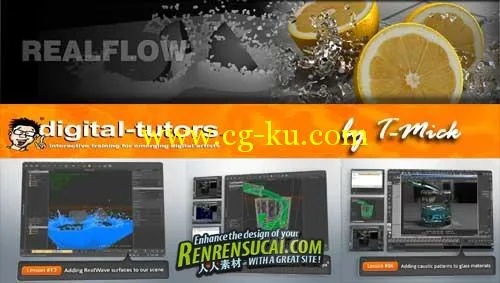由Digital Tutors 公司最新出品的Digital Tutors Pipeline Integration with Maya 2011 and RealFlow 5 教程,Maya 2011和RealFlow 5整合教程。Maya 2011和RealFlow 5相结合可以制作出许多惊人的特效。释放时间2010年10月1
RealFlow 5可以创建出易于控制并且非常真实的高级流体模拟效果。RealFlow 5带给我们很多最新特性,在稳定性和速度方面都有很大提高。大部分用户都认为最新的版本比旧版提供了更有趣更具意义的操作性能。你可以通过观看CG电影“I Robots”(机器人)来领略RealFlow制作出的优秀效果。
RealFlow专用于水面波浪的模拟,如海面、落入物体后水面泛起的涟漪、行驶在水中的船(包括破浪泛起的粒子水花和产生的水面拖尾),能够完成的项目包括:物体落入水面后激起波浪,并且随水面上下波动,还能产生溅起的水花。粒子落在水面上泛起的涟漪。在水面上快速运动的物体产生尾迹、水花和波浪,常用于船只的航行模拟。表现动态、自然波动的水面,如湖泊、水池、海洋等,还能产生海水拍岸溅起海浪水花的效果。
教程所使用的软件:Maya 2011 and higher, RealFlow 5 and higher
In this series of lessons we will learn how Maya and RealFlow can be used together for our projects.
We will begin this course by learning how to import RealFlow meshes into Maya, and we will go step-by-step through the process of adding lights, materials and proper render settings to mimic appearance of realistic glass and liquid materials. From there, we will go deeper into the integration process, learning how to take geometry from Maya into RealFlow, using RealFlow's soft and rigid body dynamics to create moving objects, as well as understanding how scene scale plays a critical role in the behavior of our simulations. We will learn how to cache and re-use RealFlow simulation data and discuss many tips, tricks and techniques that you will be able to use in both the simulation and the rendering stages of your RealFlow projects.
1. Introduction and project overview
3. Applying Maya materials to RealFlow meshes
5. Adding colored shadows to dielectric materials
7. Making final adjustments to render quality
9. Creating soft and rigid body objects in RealFlow
11. Caching soft body simulations from RealFlow
13. Adding RealWave surfaces to our scene
15. Importing RealFlow objects into Maya
17. Adding a reflective environment to our Maya scene
19. Adding soft shadows to our Maya scene
21. Blending RealFlow meshes together in Maya
23. Fixing artifacts in Maya Architectural Material
25. Generating the RealFlow project files for this course
2. Exporting meshes from RealFlow into Maya
4. Adjusting raytrace settings in Maya
6. Adding caustic patterns to glass materials
8. Importing Maya geometry into RealFlow
10. Adjusting soft body results in RealFlow
12. Adding detailed splashes to our RealFlow project
14. Generating meshes around RealFlow particles
16. Setting up materials for the lemon geometry
18. Increasing reflection and refraction rays in Maya
20. Fixing reflection and refraction errors
22. Adding secondary illumination to the scene
24. Using the RealFlow Melt Shader in Maya
Pipeline Integration with Maya 2011 and Realflow 5 | .flv | 941Mb
In this series of lessons we will learn how Maya and RealFlow can be used together for our projects.
We will begin this course by learning how to import RealFlow meshes into Maya, and we will go step-by-step through the process of adding lights, materials and proper render settings to mimic appearance of realistic glass and liquid materials. From there, we will go deeper into the integration process, learning how to take geometry from Maya into RealFlow, using RealFlow's soft and rigid body dynamics to create moving objects, as well as understanding how scene scale plays a critical role in the behavior of our simulations. We will learn how to cache and re-use RealFlow simulation data and discuss many tips, tricks and techniques that you will be able to use in both the simulation and the rendering stages of your RealFlow projects.
1. Introduction and project overview
2. Exporting meshes from RealFlow into Maya
3. Applying Maya materials to RealFlow meshes
4. Adjusting raytrace settings in Maya
5. Adding colored shadows to dielectric materials
6. Adding caustic patterns to glass materials
7. Making final adjustments to render quality
8. Importing Maya geometry into RealFlow
9. Creating soft and rigid body objects in RealFlow
10. Adjusting soft body results in RealFlow
11. Caching soft body simulations from RealFlow
12. Adding detailed splashes to our RealFlow project
13. Adding RealWave surfaces to our scene
14. Generating meshes around RealFlow particles
15. Importing RealFlow objects into Maya
16. Setting up materials for the lemon geometry
17. Adding a reflective environment to our Maya scene
18. Increasing reflection and refraction rays in Maya
19. Adding soft shadows to our Maya scene
20. Fixing reflection and refraction errors
21. Blending RealFlow meshes together in Maya
22. Adding secondary illumination to the scene
23. Fixing artifacts in Maya Architectural Material
24. Using the RealFlow Melt Shader in Maya
25. Generating the RealFlow project files for this course



发布日期: 2010-10-11